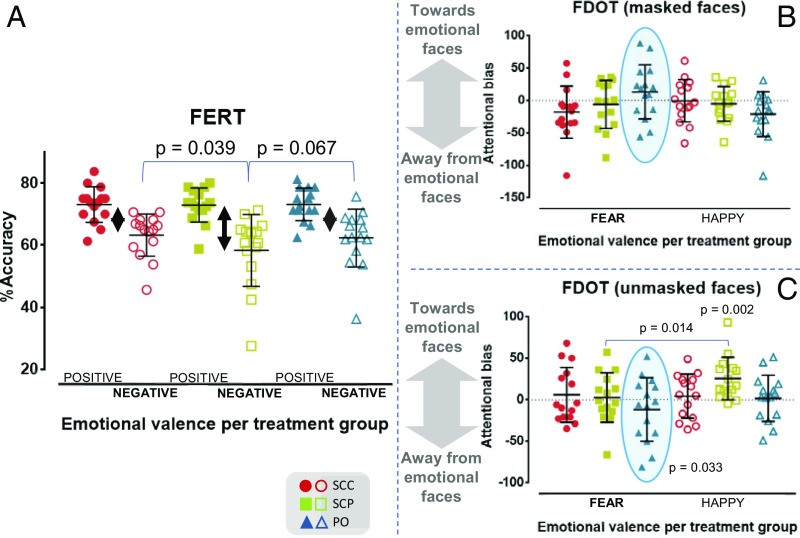Fig. 4.
(A) Behavioral data on emotional face recognition. The scatterplot shows the %accuracy scores for recognizing positively valenced (happy, surprise) and negatively valenced facial expressions (sad, angry, fearful, disgusted) per treatment group. Similar to what has been observed as an effect of established antidepressant and anxiolytic agents on healthy male volunteers, the pulsatile GC rhythm approximating physiology (SCP) increases the within-group difference in the accuracy scores between correctly identifying positively valenced from negatively valenced human faces (double-headed black arrows). This phenomenon occurs as the result of the comparatively reduced accuracy of subjects in the SCP group in correctly identifying faces expressing negative emotions (on average by 4.9% vs. SCC; P = 0.029 and on average by 4% vs. PO; P = 0.067). More details are provided in SI Appendix, Fig. S2. (B) Behavioral data on emotion-related attentional bias at the subliminal level (masked faces). The scatterplot presents each treatment group’s vigilance scores toward (positive values) or away (negative values) from masked fearful and happy faces. (C) Scatterplot presenting each treatment group’s vigilance scores toward (positive values) or away (negative values) from unmasked fearful and happy faces. In the SCP group, there is a significant difference (P = 0.014) in the vigilance score between unmasked fearful and happy faces. Moreover, in the PO group, there is a strong trend for changing the direction of the attentional bias when going from masked to unmasked fearful faces (light-blue ellipsoidal frame in B and C; P = 0.067 not shown in figure). Moreover, the PO group showed a statistically significant absolute bias away from unmasked fearful faces (P = 0.033), and the SCP group showed a statistically significant absolute bias toward unmasked happy faces (P = 0.002). Overall, fast-acting neural processing of fearful faces in the SCP group and of happy faces in the SCC group led to minimal attentional bias. In all other cases, the transition from subliminal to more conscious attentional mechanisms led to changes in the direction of the attentional bias, either from stimulus avoidance to vigilance or, only for the processing of fearful faces in the PO group, vice versa.

